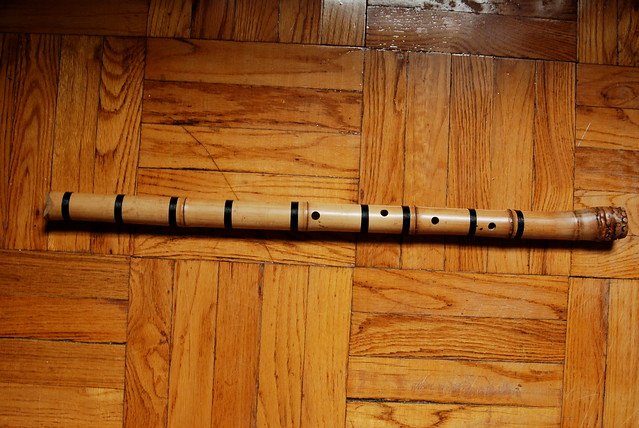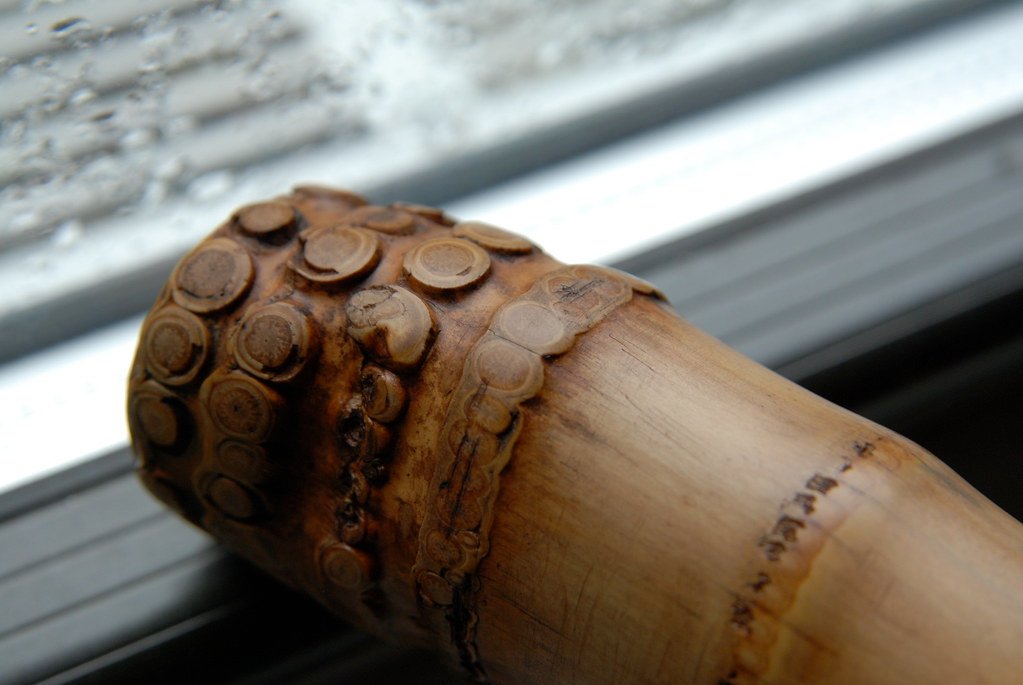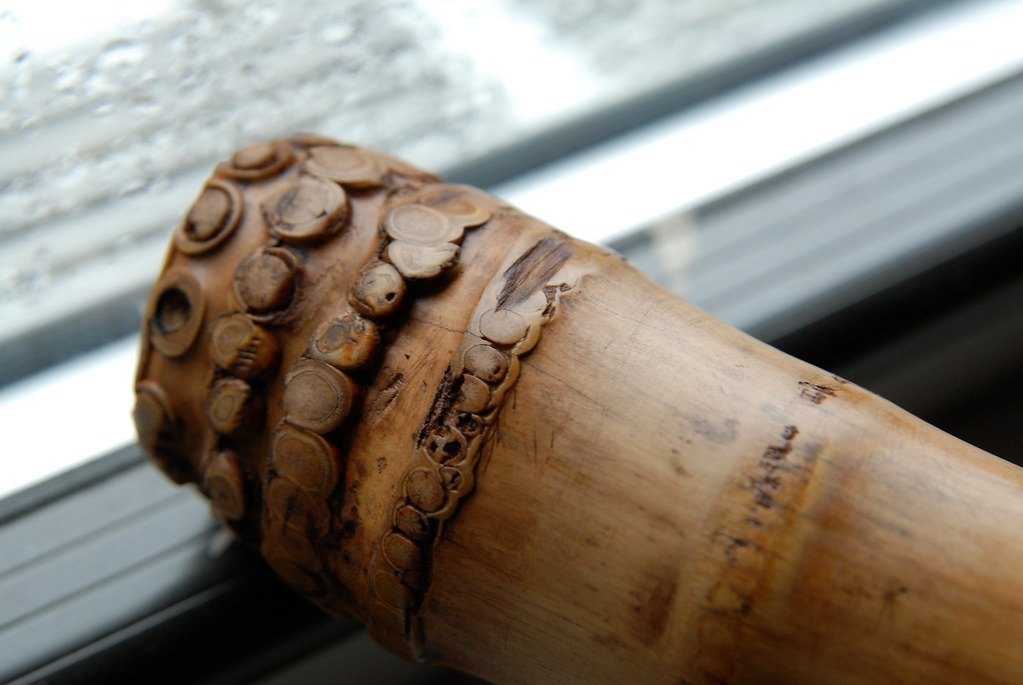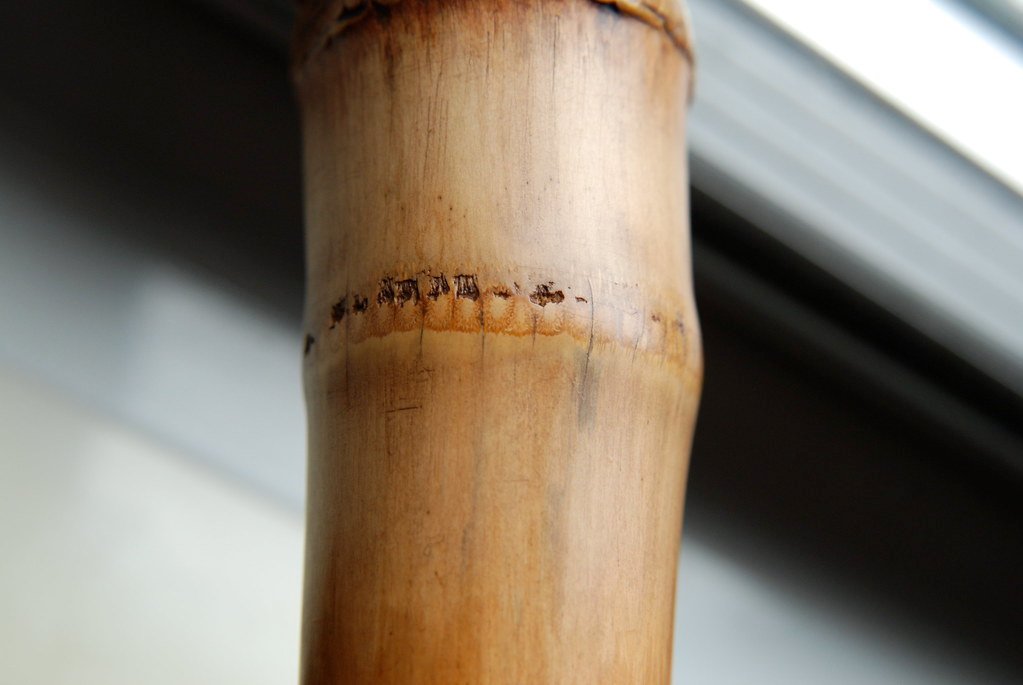Many small surface cracks developing on root end?
Many small surface cracks developing on root end?
Hello All,
First post. Nice to be aboard!
Over the last couple weeks, I have been making a 2.45 jinashi out of a root end piece of Chinese madake I picked up from Perry Yung. I believe the culm had been aging at his home for at least several years, but I didn't ask him. 4 days ago I began noticing two very small hairline surface cracks running through one of the already shaved and sanded root end nodes. Then, 3 days ago, I decided to sand the outer surface of the node closest to the root end (a different node than the one with surface cracks) smooth because I didn't like its rough pitted look. The next day, that sanded outer node had at least 10 very small hairline surface cracks all through it. 2 days ago, I bound the upper sections of the flute in 9 places with nylon cord, but did not bind the root end because the cracks seemed so superficial, and I've very rarely seen a flute with bindings right near/on the actual root part.
My concern is that the superficial cracks at the root end are beginning to get slightly longer and wider today. They are still only superficial hairline cracks though. I wrapped the whole flute in a damp tee shirt, and have it in a trash bag overnight so the small cracks can hopefully seal back up. I know pictures would really help in this situation, but it's dark, and I have to wait until morning to get some decent shots. In the meantime, I am curious how common it is to see many small hairline surface cracks at a root end? Are these generally cause for concern? Is wrapping the flute in a damp tee shirt overnight overkill, or a good idea?
FWIW, before I started worrying about the cracks tonight, I did wipe a layer of brown shoe polish on the root end to darken it, and to give it back some shine after the sanding job. (Something I learned from Seri Indian ironwood carvers in Mexico.) I think the shoe polish brought the cracks into greater visual detail, but is it possible the shoe polish might physically help the cracks to grow somehow?
Sorry if I'm freaking out a bit. This is the first root end I've ever made, and I really love how it plays already! To me, it's already a special flute, and I'd hate to have it crack so soon. Pictures to follow tomorrow.
This is the first root end I've ever made, and I really love how it plays already! To me, it's already a special flute, and I'd hate to have it crack so soon. Pictures to follow tomorrow.
First post. Nice to be aboard!

Over the last couple weeks, I have been making a 2.45 jinashi out of a root end piece of Chinese madake I picked up from Perry Yung. I believe the culm had been aging at his home for at least several years, but I didn't ask him. 4 days ago I began noticing two very small hairline surface cracks running through one of the already shaved and sanded root end nodes. Then, 3 days ago, I decided to sand the outer surface of the node closest to the root end (a different node than the one with surface cracks) smooth because I didn't like its rough pitted look. The next day, that sanded outer node had at least 10 very small hairline surface cracks all through it. 2 days ago, I bound the upper sections of the flute in 9 places with nylon cord, but did not bind the root end because the cracks seemed so superficial, and I've very rarely seen a flute with bindings right near/on the actual root part.
My concern is that the superficial cracks at the root end are beginning to get slightly longer and wider today. They are still only superficial hairline cracks though. I wrapped the whole flute in a damp tee shirt, and have it in a trash bag overnight so the small cracks can hopefully seal back up. I know pictures would really help in this situation, but it's dark, and I have to wait until morning to get some decent shots. In the meantime, I am curious how common it is to see many small hairline surface cracks at a root end? Are these generally cause for concern? Is wrapping the flute in a damp tee shirt overnight overkill, or a good idea?
FWIW, before I started worrying about the cracks tonight, I did wipe a layer of brown shoe polish on the root end to darken it, and to give it back some shine after the sanding job. (Something I learned from Seri Indian ironwood carvers in Mexico.) I think the shoe polish brought the cracks into greater visual detail, but is it possible the shoe polish might physically help the cracks to grow somehow?
Sorry if I'm freaking out a bit.
 This is the first root end I've ever made, and I really love how it plays already! To me, it's already a special flute, and I'd hate to have it crack so soon. Pictures to follow tomorrow.
This is the first root end I've ever made, and I really love how it plays already! To me, it's already a special flute, and I'd hate to have it crack so soon. Pictures to follow tomorrow.
Well the humidity closed up the cracks pretty well overnight. Here are some pics:
The flute...
First root end surface crack. This was noticeably wider last night before the humidity treatment, but still what I would consider to be a hairline surface crack...
Second root end surface crack. Same situation...
This is the node I sanded down. This has many of these smaller hairline cracks all through the node. These never got much wider than they are now, but just a tad bigger...
I suppose I could add a couple more bindings, but I've never seen a flute bound right at the root end like that. If these cracks are nothing to be concerned about, I'd prefer to not bind them for aesthetic reasons. Maybe rub a bit of wood glue into them? I've read that might not really help anyway. Any opinions? Thanks
The flute...

First root end surface crack. This was noticeably wider last night before the humidity treatment, but still what I would consider to be a hairline surface crack...

Second root end surface crack. Same situation...

This is the node I sanded down. This has many of these smaller hairline cracks all through the node. These never got much wider than they are now, but just a tad bigger...

I suppose I could add a couple more bindings, but I've never seen a flute bound right at the root end like that. If these cracks are nothing to be concerned about, I'd prefer to not bind them for aesthetic reasons. Maybe rub a bit of wood glue into them? I've read that might not really help anyway. Any opinions? Thanks
Hi, Michael...
Hairline cracks around the root area are pretty common and, typically, remain that way, posing no real problem. The majority of flutes I see have one or more. Binding below N4 is only so effective since, given the density of bamboo in that area, if it really wants to crack wide open, there's not much that can stop it.
It can't hurt to be cautious, especially if they start to creep and/or widen, but I usually don't worry about the little hairline cracks; it's just part of the character of bamboo.
I'm sure others can provide their experience, as well.
Hairline cracks around the root area are pretty common and, typically, remain that way, posing no real problem. The majority of flutes I see have one or more. Binding below N4 is only so effective since, given the density of bamboo in that area, if it really wants to crack wide open, there's not much that can stop it.
It can't hurt to be cautious, especially if they start to creep and/or widen, but I usually don't worry about the little hairline cracks; it's just part of the character of bamboo.
I'm sure others can provide their experience, as well.
Thanks Derek, that makes me feel better. I owned a root end earth model flute from Perry for several years, and don't remember seeing any cracks like this, so I was a bit worried. I'm wondering if it was something I did wrong in the making process? If others want to share their experience/advice, I'd welcome their knowledge.
Just found this pic on Perry's blog. Looks like there are the same type of small surface cracks on the sanded nodes here too:

Maybe it wasn't my making technique after all.

Maybe it wasn't my making technique after all.

"Christian Grobmeier""Christian Grobmeier"Jun Shinan once said: a Shakuhachi without a crack is a Shakuachi without a face.
Then I guess mine is a princess cut diamond.
 Thanks for the reassurance everyone. I will sleep easier tonight!
Thanks for the reassurance everyone. I will sleep easier tonight!
Hello Michael just to say I have made a bunch of flutes and I think I have one that has no cracks it is the nature of bamboo.I have rubbed a tiny bit of super glue in the past which has worked but these days unless I think it's going to get worse I don't worry about it. Even the most expensive crafted instruments can have repaired cracks but dosn't effect the value.Hope this helps
Répondre
